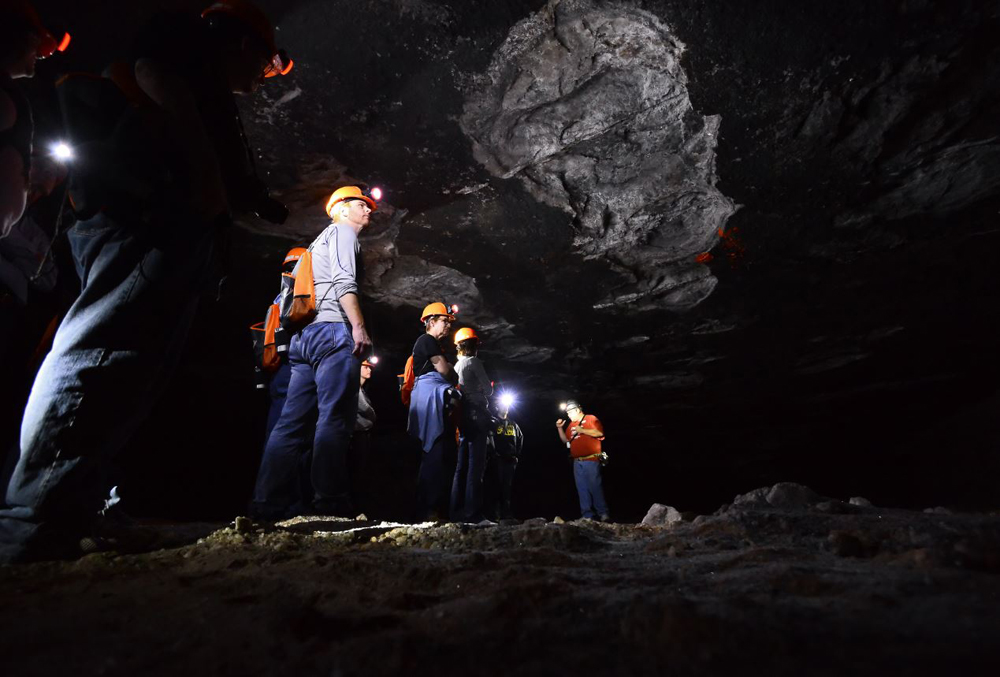
Kansas Salt Safari Unveils Glittering Underground World

For some people it's a mountaintop, for others it's a lapping seashore, but for Gayle Ferrell, the most serene place on Earth is 650 feet (198 meters) underground.
Ferrell works as the director of operations at a museum called Strataca, set in the abandoned tunnels of an active salt mine in central Kansas. The museum — which has access to about 300,000 square feet (28,000 square meters) of mined-out channels — has been open since 2007, but just unveiled a new attraction in November called the Salt Safari that brings visitors through an extended 3-hour-long sub-surface hike.
Clad in hard hats and carrying Mine Safety and Health Administration self-rescuer devices (breathing apparatuses used by miners in emergencies), visitors descend hundreds of feet in a freight elevator and enter a world covered in glittering, geometric salt crystals. [Album: Hike the Strataca Salt Safari]
A retired salt miner and the museum's maintenance manager together lead the group through the tunnels, explaining how the mining operations work and how the shimmering deposits formed.
"This is not a museum where you read boards and that's it," Ferrell told LiveScience's OurAmazingPlanet. "You go 650 feet underground. This is the only place in North American where the public can do that, and go into an active salt mine."
Wonder of Kansas
The museum was listed by the Kansas Sampler Foundation as one of the "8 Wonders of Kansas" in 2007, a list that includes several other natural wonders and culturally significant sites. Strataca has since drawn about 55,000 visitors annually from all 50 states, along with 25 countries around the world, Ferrell said.
Sign up for the Live Science daily newsletter now
Get the world’s most fascinating discoveries delivered straight to your inbox.
Though she says she had held a better paying job at an accounting firm before joining Strataca several years ago, Ferrell has never regretted her decision to spend her days underground.
"It is a very serene and calming atmosphere, and time passes in a whole different dimension," Ferrell said. "Three hours seems like 30 minutes."
The salt deposits that make up this unique environment formed about 250 million years ago, when modern-day Kansas sat close to the equator and was more arid than it is today.
"It would have been a hot environment without a lot of rain," Shane Lyle, senior research assistant with the Kansas Geological Survey, told LiveScience, comparing the area's ancient climate to that around the modern-day Arabian Sea. (Lyle informally advises Strataca on geologic content in its exhibits.)
During that ancient time, a body of water called the Permian Sea covered large parts of what is now North America. The site of the salt mine formed a shallow embayment to the north of the sea, cut off from the larger body of water.
Through time, water evaporated from the isolated body of water, leaving salt behind. Eventually, the salt became so concentrated that it fell out of solution and formed crystals on the seafloor, Lyle said.
Buried salts
Over the course of millions of years, the embayment and the rest of the Permian Sea cyclically dried up, flooded, and dried up again about 15 times, as a result of global changes in climate: Cool climates tend to suck water up to the poles where it is stored as ice in glaciers, Lyle said. Each time the sea dried up, hundreds of feet of salts settled, later to be covered by muds. Eventually, under the weight of overlying deposits, the salts hardened and the mud turned to shale rock through a process called lithification, Lyle said.
Today, the mine's product is distributed throughout the Midwest and Northeast as road salt to help melt ice during winter months. Some abandoned mined-out areas have also been leased by a company called Underground Vaults and Storage, which offers its clients a secure and naturally climate-controlled environment to store valuable items, including a number of original Hollywood movies, according to the Strataca website.
Aside from the adventure component of the Salt Safari, Ferrell says that the museum aims to provide a compelling educational experience for the thousands of school students that visit each year, some of whom get the unique chance to spend a night in the mine.
Follow Laura Poppick on Twitter. Follow OurAmazingPlanet @OAPlanet, Facebook and Google+. Original article at LiveScience's OurAmazingPlanet.











